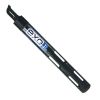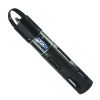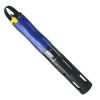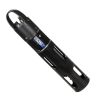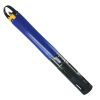YSI EXO Conductivity & Temperature Sensor
Features
- 0 to 200 mS/cm measurement range
- T63<2 sec response time
- ±0.5% of reading or 0.001 mS/cm accuracy from 0 to 100
- Free ground shipping
- Expedited repair and warranty service
- Lifetime technical support
- More
Overview
The YSI EXO conductivity & temperature sensor is a digital smart sensor featuring welded titanium construction and wet-mateable connectors. The sensor provides accurate and fast temperature data and enables temperature compensation for other EXO probes. Conductivity data is used to calculate salinity, non-linear function (nLF) conductivity, specific conductance, and total dissolved solids, and compensate for changes in the density of water (as a function of temperature and salinity) in depth calculations if a depth sensor is installed.
Temperature Thermistor
The temperature sensor uses a highly stable and aged thermistor with low-drift characteristics. The thermistor’s resistance changes with temperature. The measured resistance is then converted to temperature using an algorithm. The temperature sensor receives a multi-point NIST traceable wet calibration, and the accuracy specification of 0.01˚C is valid for the expected life of the probe. No calibration or maintenance of the temperature sensor is required, but accuracy checks can be conducted.
Conductivity Electrodes
The conductivity sensor uses four internal, pure-nickel electrodes to measure solution conductance. Two of the electrodes are current-driven, and two are used to measure the voltage drop. The measured voltage drop is then converted into a conductance value in milliSiemens (millimhos). To convert this value to a conductivity value in milliSiemens per cm (mS/cm), the conductance is multiplied by the cell constant that has units of reciprocal cm (cm-1). The cell constant for the conductivity cell is approximately 5.5/cm ±10%. For most applications, the cell constant is automatically determined (or confirmed) with each deployment of the system when the calibration procedure is followed.
Temperature Compensation
EXO sensors have internal thermistors for quality assurance purposes. Turbidity uses the internal thermistor for temperature compensation, while all other EXO sensors reference the C/T probe for temperature compensation. To display and log temperature, a C/T probe must be installed in an EXO sonde. Thermistor readings are logged in the sonde’s raw data–viewable in KOR software–but are not included in data exported to Excel.
In The News
YSI EXO3s: The Latest in Water Quality Monitoring
The YSI EXO3s offers the latest in multi-parameter water quality monitoring equipment that has a comprehensive list of smart sensors. With an external power source, this sonde is a cost-effective, compact EXO that has the same capabilities as the EXO3 . The sonde is built to last with resilient materials and backed with vigorous testing. The device has five ports for available YSI EXO smart sensors or central wiper. It seamlessly integrates with a data logger to collect and push valuable data to the cloud for access from a PC or mobile device. This small sonde is exceptional for both sampling and continuous monitoring applications.
Read MoreFrom Paddles to Phytoplankton: Studying Vermont’s Wildest Lakes
For six months of the year, Rachel Cray, a third-year PhD student at the Vermont Limnology Laboratory at the University of Vermont, lives between a microscope and her laptop, running data. For the other six months, she is hiking and canoeing four of Vermont’s lakes, collecting bi-weekly water samples. Cray studies algal phenology across four lakes in Vermont, US, that have low anthropogenic stress—or in other words, are very remote. Funded by the National Science Foundation Career Award to Dr. Mindy Morales, the lakes Cray researches part of the Vermont Sentinel Lakes Program, which studies 13 lakes in the area and, in turn, feeds into the Regional Monitoring Network, which operates in the Northeast and Midwest US.
Read MoreReimagining Water Filtration: How Monitoring and Science Enhance FloWater Filtration Systems
Over 50% of Americans think their tap water is unsafe , according to the Environmental Working Group (EWG). Other recent surveys have found that number to be as high as 70% of persons surveyed. Whether due to increased public awareness of water quality issues or confusion about how municipal water sources are regulated, there is a clear distrust of tap water in the United States. According to industry expert Rich Razgaitis, CEO and co-founder of the water purification company FloWater, this issue creates a damaging cycle. Razgaitis explained that the health and environmental problems associated with contaminated water aren’t the only issues. As people become increasingly aware that some tap water is unsafe, they resort to bottled water.
Read More










